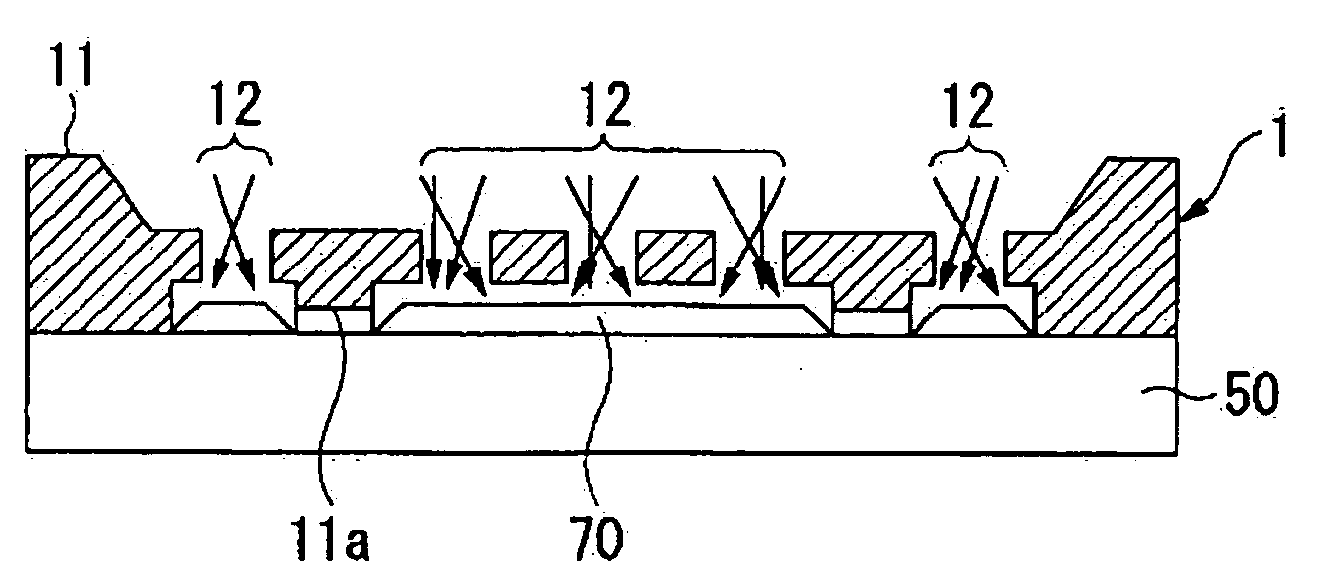Film forming method, electronic device and electronic apparatus
a technology of electronic devices and films, applied in vacuum evaporation coatings, transportation and packaging, coatings, etc., can solve the problems of increasing product costs, consuming a large amount of resist, and taking a long time to complete a process of vapor-phase deposition, so as to achieve low cost and low cost. , the effect of low cos
- Summary
- Abstract
- Description
- Claims
- Application Information
AI Technical Summary
Benefits of technology
Problems solved by technology
Method used
Image
Examples
first embodiment
A Film Forming Method
[0032] Next, a method of forming a pattern of the metal wiring 52 on a glass substrate 50 by using the mask 10 is described.
[0033]FIG. 2 shows a process for forming the electrical wiring 52 by using the mask 10. FIG. 3 shows the electrical wiring 52 formed by the process.
[0034] A substrate for forming the metal wiring 52 is not limited to a glass substrate 10 and other substrates may be used including a plastic substrate or a silicon substrate.
[0035] First, a metal base layer 60 is formed on the substrate 50 using the mask 10 by physical vapor-phase deposition such as evaporation and sputtering or a vapor-phase deposition such as CVD. The material of the metal base layer 60 is preferably gold or nickel. The following example is a case when nickel is used.
[0036] In detail, as shown in FIG. 2A, the surface 11a of the mask 10 is tightly attached to the glass substrate 50. Then, the metal base layer 60 made of nickel is formed by physical vapor-phase deposition...
second embodiment
A Film Forming Method
[0047] Next, a case of using aluminum as a metal base layer 70 is explained in a method of forming a pattern of a metal wiring 54 on the glass substrate 50 by using the mask 10.
[0048]FIGS. 4A to 4E are sequential steps of forming the metal wiring 54.
[0049] As shown in FIG. 4A, when aluminum film is formed as the metal base layer 70, the metal base layer 70 is formed on the glass substrate 50 with the mask 10 by an evaporation method, a physical vapor-phase growth method such as sputtering and a physical chemical vapor-phase growth method such as CVD. The thickness of the metal base layer 70 made of aluminum is preferably about 700 nm. Here, in order to form the metal film 70 made of aluminum, an oxide film formed on the surface must be removed to yield the metal film 70 made of aluminum having a thickness of around 100 nm, which is thicker than the metal film made of nickel.
[0050] The material for forming the metal base layer 70 may be an aluminum alloy. For...
PUM
| Property | Measurement | Unit |
|---|---|---|
| width | aaaaa | aaaaa |
| distance | aaaaa | aaaaa |
| thickness | aaaaa | aaaaa |
Abstract
Description
Claims
Application Information
 Login to View More
Login to View More - R&D
- Intellectual Property
- Life Sciences
- Materials
- Tech Scout
- Unparalleled Data Quality
- Higher Quality Content
- 60% Fewer Hallucinations
Browse by: Latest US Patents, China's latest patents, Technical Efficacy Thesaurus, Application Domain, Technology Topic, Popular Technical Reports.
© 2025 PatSnap. All rights reserved.Legal|Privacy policy|Modern Slavery Act Transparency Statement|Sitemap|About US| Contact US: help@patsnap.com



